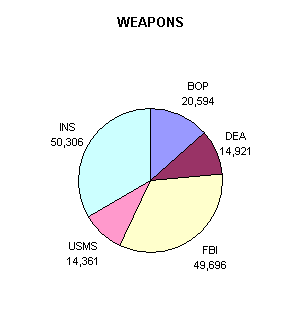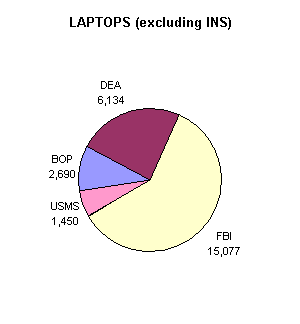(BASED ON NUMBER OF EMPLOYEES)11

The Department of Justice's
Control Over Weapons and Laptop Computers
Summary Report
Report No. 02-31
August 2002
Office of the Inspector General
The Department of Justice (Department), established in 1870,10 seeks to enforce the law and defend the legal interests of the United States, provide federal leadership in preventing and controlling crime, administer and enforce the Nation's immigration laws, and ensure fair and impartial administration of justice for all Americans.
The Department is composed of law enforcement bureaus and various offices, boards, and divisions, each with its own mission, goals, and resources. The majority of the law enforcement functions are performed by five components: the Federal Bureau of Prisons (BOP), the Drug Enforcement Administration (DEA), the Federal Bureau of Investigation (FBI), the Immigration and Naturalization Service (INS), and the United States Marshals Service (USMS), collectively referred to in this report as the components.
Within the Department, the components serve a myriad of purposes and assist the Department in different ways. Background information for each of the components is shown in the following table.
COMPONENT INFORMATION
| COMPONENT & DATE ESTABLISHED |
AREA OF RESPONSIBILITY/MISSION |
NUMBER OF OFFICES |
|---|---|---|
| BOP -- 1930 | To protect the public's safety by ensuring federal offenders serve their imprisonment in safe, secure, cost-efficient, humane institutions and encouraging inmates to participate in programs designed to help them adopt a crime-free lifestyle upon their return to the community. | Headquarters, 3 training centers, 103 institutions, 6 regional offices, and 29 community corrections offices |
| DEA -- 1973 | To enforce the controlled substance laws and regulations of the U.S. | Headquarters,1 training facility,21 domestic offices, and 78 foreign offices |
| FBI -- 1909 | To investigate crimes against the U.S., including counterterrorism, drugs/organized crime, foreign counterintelligence, violent crimes, and white-collar crimes. | Headquarters, 1 training facility, 56 field offices, and 47 overseas offices |
| INS -- 1940 | To administer and enforce the nation's immigration laws. | Headquarters, 3 regional offices, 33 U.S. district offices, 3 overseas district offices, and 21 border patrol sectors |
| USMS -- 1789 | To protect the federal courts and ensure the secure operation of the judicial system, including apprehending fugitives, protecting witnesses, and transporting prisoners. | Headquarters, 94 U.S. district offices, 1 special operations facility, and 1 training facility |
| Source: Component History and Organizational Documents |
As the missions of the components vary, the number of employees necessary to carry out the responsibilities also varies. In total, the components employ 112,221 people, 3,443 of which are contract court security officers for the USMS; the following chart shows the relative size of each component.
| COMPONENT SIZE (BASED ON NUMBER OF EMPLOYEES)11 |
|---|
 |
The responsibilities of the components require them to maintain an inventory of sensitive property, including weapons and laptop computers, to assist in performing their missions. Together, the components have 149,878 weapons and 25,351 laptop computers. The relative sizes of the components' inventory of weapons and laptop computers appear in the following charts.
| WEAPON AND LAPTOP COMPUTER INVENTORIES | ||
|---|---|---|
 |
 |
|
OIG Audits of Weapons and Laptop Computers in the Components
In March 2001, the Office of the Inspector General (OIG) audited the INS's management of its property and found, among other things, that the INS did not have adequate controls over property, including weapons.12 In particular, the audit noted that the INS identified more than 500 weapons as lost, missing, or stolen. After that audit, and as a result of inquiries from the Congress and the Webster Commission,13 the FBI reported over 400 weapons and 180 laptop computers were missing from its inventory.14
In response to concerns about the Department's accountability for its weapons and laptop computers, the Attorney General requested the OIG to conduct audits of the controls over the inventory of such property throughout the Department. This property is sensitive in nature and could result in danger to the public or compromise national security or law enforcement investigations if not properly controlled. We therefore conducted audits and issued separate reports on the BOP, DEA, FBI, and USMS's controls over weapons and laptop computers.15
This report is a capping report that summarizes the five audits noted above, each of which was performed in accordance with Government Auditing Standards.16 In addition, to the extent possible, we have compared and contrasted the components' policies, procedures, and practices. However, in many instances we were unable to include the INS in this analysis because the scope and methodology of that audit did not correspond to our other audits.17 This capping report also includes an assessment of the Department's role and responsibilities regarding the controls over weapons and laptop computers. At the conclusion, we provide recommendations for improving the Department's accountability of these types of sensitive property.